NCERT Exemplar Solutions: Reproduction in Plants | Science Class 7 PDF Download
| Table of contents |

|
| Multiple Choice Questions |

|
| Very Short Answer Questions |

|
| Short Answer Questions |

|
| Long Answer Questions |

|
Multiple Choice Questions
Q.1. Which of the following parts of a plant take part in sexual reproduction?
(i) Flower
(ii) Seed
(iii) Fruit
(iv) Branch Choose the correct answer from below.
(a) (i) and (ii)
(b) (i), (ii) and (iii)
(c) (iii) and (iv)
(d) (ii), (iii) and (iv)
Ans: b
Explanation:
Functions of sexual reproduction are carried out by flowers. After fertilization, the ovaries grow into fruits and seeds develop from ovules.
Q.2. Lila observed that a pond with clear water was covered up with green algae within a week. By which method of reproduction did the algae spread so rapidly?
(a) Budding
(b) Sexual reproduction
(c) Fragmentation
(d) Pollination
Ans: c
Explanation:
An alga breaks up into two or more fragments. These fragments or pieces grow into new individuals. This process continues and they cover a large area in a short period of time.
Q.3. Seeds of drumstick and maple are carried to long distances by wind because they possess
(a) winged seeds
(b) large and hairy seeds
(c) long and ridged fruits
(d) spiny seeds
Ans: a
Explanation:
Seeds of drumstick and maple have wings which help them to be easily carried away by the wind. Various seeds and fruits have some special feature due to which they are carried away in a particular way (by wind, water or animal).
Q.4. The ‘eye’ of the potato plant is what
(a) the root is to any plant.
(b) the bud is to a flower.
(c) the bud is to Bryophyllum leaf.
(d) the anther is to stamen
Ans: c
Explanation:
Eye of the potato is the vegetative bud which arises from nodes of stem tuber. Just like potato, bryophyllum leaf has vegetative buds.
Q.5. The ovaries of different flowers may contain
(a) only one ovule
(b) many ovules
(c) one to many ovules
(d) only two ovules
Ans: c
Q.6. Which of the following statements is/are true for sexual reproduction in plants?
(i) Plants are obtained from seeds.
(ii) Two plants are always essential.
(iii) Fertilisation can occur only after pollination.
(iv) Only insects are agents of pollination.
Choose from the options given below.
(a) (i) and (iii)
(b) (i) only
(c) (ii) and (iii)
(d) (i) and (iv)
Ans: a
Explanation:
For sexual reproduction in plants occurs within a plant hence option ii) is wrong . Pollinations is carried by various agents such as wind, insects and animals hence option iv) is wrong.
Q.7. Pollination refers to the
(a) transfer of pollen from the anther to the ovary.
(b) transfer of male gametes from the anther to stigma.
(c) transfer of pollen from the anther to stigma.
(d) transfer of pollen from the anther to the ovule.
Ans: c
Explanation:
The transfer of pollen grains from the anther to the stigma is called pollination. Pollen grains are immobile, they cannot move by themselves to reach the stigma. An external agent such as wind and insects are required for this.
Very Short Answer Questions
Q.1. Fungus, moss and fern reproduce by a common method of asexual reproduction. Name the method.
Ans: Fungus, moss and fern reproduce by spore formation.
Q.2. Pick the odd one out from the following on the basis of mode of reproduction and give reason for it.
Sugarcane, Potato, Rice, Rose
Ans: Rice does not reproduce by vegetative propagation whereas the other three plants do. Hence Rice is the odd one.
Q.3. Boojho had the following parts of a rose plant – a leaf, roots, a branch, a flower, a bud and pollen grains. Which of them can be used to grow a new rose plant?
Ans: A branch can be used to grow a new rose plant
Q.4. Which type of pollination does Figure indicate?
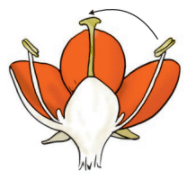
Ans: Self –Pollination
Q.4. One morning as Paheli strolled in her garden she noticed many small plants which were not there a week ago. She wondered where they had come from as nobody had planted them there. Explain the reason for the growth of these plants.
Ans: The seeds from the tree may have fallen below and germinated into small plants. The seeds might have brought to the garden by agents like a wind which germinated and grown into small plants.
Short Answer Questions
Q.1. In the diagram given in Figure label the parts marked (a), (b) and (c).
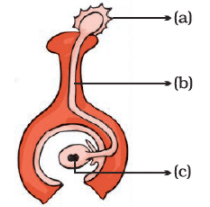
Ans:
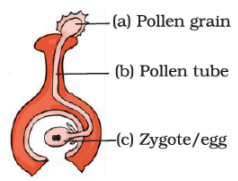
Q.2. When you keep food items like bread and fruits outside for a long time especially during the rainy season, you will observe a cottony growth on them.
(a) What is this growth called?
(b) How does growth take place?
Ans:
a) It is a bread mold which is a fungus
b) Bread mold grows from the spores.
Q.3. Group the seeds given in Figure (i) to (iii) according to their means of dispersion.
(a) Seed dispersed by wind
(b) Seed dispersed by water
(c) Seed dispersed by animal
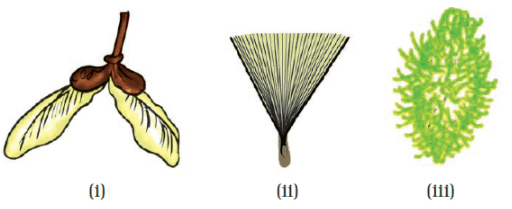
Ans:
i) and ii) are dispersed by wind;
iii) is dispersed by an animal.
Q.4. Coconut is a large and heavy fruit. How is it adapted for dispersal by water?
Ans: Coconut fruit has spongy fibers on its surface which make it float in water.
 |
Download the notes
NCERT Exemplar Solutions: Reproduction in Plants
|
Download as PDF |
Long Answer Questions
Q.1. In the figure of a flower given in Figure, label the parts whose functions are given below and give their names.
(a) The part which contains pollen grains.
(b) The part where the female gamete is formed.
(c) The female reproductive part where pollen grains germinate.
(d) The colourful part of the flower which attracts insects.

Ans:
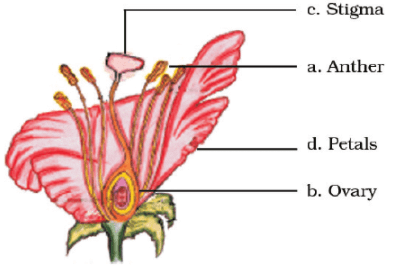
Q.2. Fill in the blanks with correct terms.
The male and female gametes fuse to form a _____(a)______ during the process of _____(b)______. This grows into an _____(c)______ which is enclosed within a seed. After fertilisation the ovules develop into _____(d)______ and the ovary develops into a _____(e)______ .
Ans: The male and female gametes fuse to form a (a) zygote during the process of (b) fertilization. This grows into an (c) embryo which is enclosed within a seed. After fertilisation, the ovules develop into (d) seed and the ovary develops into a (e) fruit.
Q.3. In the diagram of a bisexual flower given as Figure, draw the missing part and label the parts marked (a), (b) and (c). Also, label the missing part that you draw.
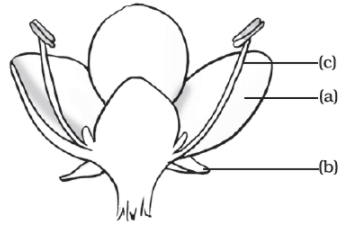
Ans:
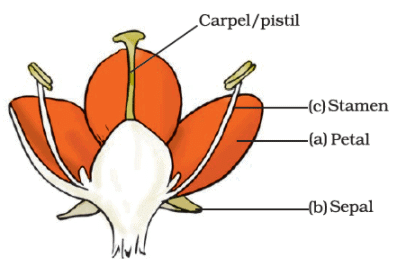
Q.4. Write how the following seeds are dispersed.
(a) Seeds with wings.
(b) Small and light seeds.
(c) Seeds with spines/hooks.
Ans:
(a) Seeds with wings are dispersed by wind
(b) Small and light seeds are dispersed by wind
(c) Seeds with spines/hooks are dispersed by animals.
|
112 videos|252 docs|28 tests
|
FAQs on NCERT Exemplar Solutions: Reproduction in Plants - Science Class 7
| 1. What is the process of reproduction in plants? |  |
| 2. What are the different methods of asexual reproduction in plants? |  |
| 3. What is the importance of reproduction in plants? |  |
| 4. What is the role of pollination in plant reproduction? |  |
| 5. How do plants reproduce in unfavorable conditions? |  |





















